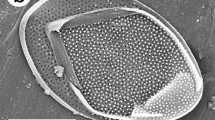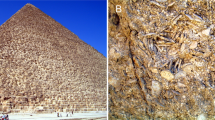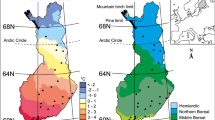Abstract
Chrysophyte algae produce siliceous resting cysts (stomatocysts) that are becoming an increasingly useful class of paleoecological indicator microfossils. This paper provides a review of the role that stomatocysts play in the life cycle and reproductive ecology of freshwater planktonic chrysophytes. Such information provides paleolimnologists with greater insight into the ecology of the vegetative, planktonic growth phase of species contributing stomatocysts to lacustrine microfossil assemblages. Specific chrysophyte reproductive characteristics discussed include: temporal dynamics of vegetative growth and encystment, cyst induction, cyst survivorship, germination requirements and recruitment strategies. This information serves as an introduction to a special issue of the Journal of Paleolimnology which is dedicated to the ‘Application of Chrysophyte Stomatocysts in Paleolimnology’.
Similar content being viewed by others
References
Adam D. P. & A. D. Mahood, 1981. Chrysophyte cysts as potential environmental indicators. Geol. Soc. Am. Bull. 92: 839–844.
Andersen, R. A., 1982. A light and electron microscopical investigation of Ochromonas sphaerocystis Matvienko (Chrysophyceae): the statospore, vegetative cell and its peripheral vesicles. Phycologia 21: 390–398.
Andersen, R. A., 1987. Synurophyceae classic nov., a new class of algae. Am. J. Bot. 74: 337–353.
Andersen, R. A., 1989. The Synurophyceae and their relationships to other golden algae. Beih. Nova Hedwigia 95: 1–26.
Asmund, B. & J. Kristiansen, 1986. The genus Mallomonas (Chrysophyceae). Opera Botanica 85: 128 pp.
Charles, D. F., 1985. Relationships between surface sediment diatom assemblages and lake water characteristics in Adirondack lakes. Ecology 66: 994–1011.
Charles, D. F. & J. P. Smol, 1988. New methods for using diatoms and chrysophytes to infer past pH of low-alkalinity lakes. Limnol. Oceanogr. 33: 1451–1462.
Charles, D. F. & J. P. Whitehead, 1986. The PIRLA Project: Paleoecological investigations of recent lake acidification. Hydrobiologia 143: 13–20.
Conrad, W., 1922. Contributions a l'etudé des Chrysomonadines. Rec. Inst. Bot. Leo Errera 10: 333–353.
Cronberg, G., 1973. Development of cysts of Mallomonas eoa examined by scanning electron microscopy. Hydrobiologia 443: 29–38.
Cronberg, G., 1980. Cyst development in different species of Mallomonas (Chrysophyceae) studied by scanning electron microscopy. Arch. Hydrobiol. Suppl. 56: 421–434.
Cronberg, G., 1982. Phytoplankton changes in Lake Trummen induced by restoration. Folia Limnol. Scand. 18: 1–119.
Cronberg, G., 1986a. Chrysophyte cysts and scales in lake sediments: a review. In Kristiansen, J. & R. A. Andersen (eds.), Chrysophytes: aspects and problems. Cambridge University Press, New York: 281–315.
Cronberg, G., 1986b. Blue-green algae, green algae and chrysophyceae in sediments. In Berglund, B. E. (ed.), Handbook of Holocene Palaeoecology and Palaeohydrology. John Wiley & Sons, New York: 507–526.
Cronberg, G., 1988. Variability in size and ultrastructure of the statospore of Mallomonas caudata. Hydrobiologia 161: 31–39.
Cronberg, G., 1989. Stomatocysts of Mallomonas hamata and M. heterospina (Mallomonadaceae, Synurophyceae) from southern swedish lakes. Nord. J. Bot. 8: 683–692.
Cronberg, G. & C. D. Sandgren, 1986. A proposal for the development of standardized nomenclature and terminology for chrysophycean statospores. In Kristiansen, J. & R. A. Andersen (eds.), Chrysophytes: Aspects and problems. Cambridge Univ. Press, New York: 317–328.
Dixit, S. S., A. S. Dixit & J. P. Smol, 1989. Relationship between chrysophyte assemblages and environmental variables in seventy-two Sudbury Lakes as examined by Canonical Correspondence Analysis (CCA). Can. J. Fish. Aquat. Sci. 46: 1667–1676.
Dixit, S. S., J. P. Smol, R. B. Davis & D. Davis 1990. Utility of scaled chrysophytes in predicting lakewater pH in northern New England lakes. J. Paleolimnol. 3: 269–286.
Duff, K. E. & J. P. Smol, 1988. Chrysophycean stomatocysts from the postglacial sediments of of a high arctic lake. Can. J. Bot. 66: 1117–1128.
Duff, K. E. & J. P. Smol, 1989. Chrysophycean stomatocysts from the postglacial sediments of Tasikutaaq Lake, Baffin Island, NWT. Can. J. Bot. 67: 1649–1656.
Duff, K. E. & J. P. Smol, 1991. Morphological descriptions and stratigraphic distributions of the chrysophycean stomatocysts from a recently acidified lake (Adirondack Park, N.Y.). J. Paleolimnol. 5: 73–113.
Elser, J. J., N. C. Goff, N. A. MacKay, A. L. St. Amand, M. M. Elser & S. R. Carpenter, 1987. Species-specific algal responses to zooplankton: Experimental and field observations in three north temperate lakes. J. Plankton Res. 9: 699–717.
Ettl, H., D. G. Müller, K. Neumann, H. A. von Stosch & W. Weber, 1967. Vegetative Fortpflanzung, Parthenogenese und Apogamie bei Algen. Encyclopedia of Plant. Physiol., vol. 18: 636–656.
Fott, B., 1959. Zür Frage der Sexualität bei den Chrysomonaden. Nova Hedwigia 1: 115–130.
Gayral, P., C. Haas & H. Lapailleur, 1972. Alternance morpholigique de generations et alternance de phases chez les Chrysophyceés. Mem. d. l. Soc. Bot. France. 1972: 215–230.
Hibberd, D. J., 1976. The ultrastructure and taxonomy of the Chrysophyceae and Prymnesiophyceae (Haptophyceae): a survey with some new observations on the ultrastructure of the Chrysophyceae. Bot. J. Linn. Soc. 72: 55–80.
Hibberd, D. J., 1977. Ultrastructure of cyst formation in Ochromonas tuberculata (Chrysophyceae). J. Phycol. 13: 309–320.
Kreis, R. G., et al., 1990. Diatom, pH relationships in the northern Great Lakes Region for predicting past lake acidity. PIRLA Interim Report, EPRI, Electric Power Research Institute, Palo Alto, CA.
Lehman, J. T. & C. D. Sandgren, 1985. Species-specific rates of growth and grazing loss among freshwater algae. Limnol. Oceanogr. 30: 34–46.
Munch, C. S., 1972. An ecological study of the planktonic chrysophytes of Hall Lake, Washington. Ph.D. Thesis. Univ. Washington, Seattle.
Nauwerck, A., 1968. Das Phytoplankton des Latnjajaure 1954–1965. Schweiz. Z. Hydrol. 30: 188–216.
Nygaard, G., 1965. Ancient and recent flora of diatoms and Chrysophyceae in Lake Gribsø. In: Berg, K. & I. C. Peterson (eds), Studies in humic, acid Lake Gribø. Folia Limnol. Scand. 8: 32–94.
Pascher, A., 1912. Über Rhizopoden und Palmellastadien bei Flagellaten (Chrysomonaden), nebst einer Übersicht über braunen Flagellaten. Arch. Protistenk. 24: 153–200.
Preisig, H. R., 1986. Biomineralization in the Chrysophyceae. In Leadbeater, B. S. C. & R. Riding (eds.), Biomineralization in Lower Plants and Animals. Clarendon Press, Oxford: 345–360.
Preisig, H. R. & D. J. Hibberd, 1983. Ultrastructure and taxonomy of Paraphysomonas (Chrysophyceae) and related genera. 3. Nord. J. Bot. 3: 695–723.
Reynolds, C. S., 1984. The Ecology of Freshwater Phytoplankton. Cambridge Univ. Press, Cambridge.
Ruttner, F., 1930. Das Plankton des Lunzer Untersees: seine Verteilung in Raum und Zeit während der Jahre 1908–1913. Int. Revue ges. Hydrobiol. 23: 1–304.
Rybak, M., 1986. The chrysophycean paleocyst flora of the bottom sediments of Kortowskie Lake (Poland) and its ecological significance. Hydrobiologia 140: 67–84.
Rybak, M., 1987. Fossil chrysophycean cyst flora of Racze Lake, Wollin Island (Poland) in relations to paleoenvironmental conditions. Hydrobiologia 150: 257–272.
Rybak, M., I. Rybak & M. Dickman, 1987. Fossil chrysophcean cyst flora in a small meromictic lake in southern Ontario, and its paleoecological interpretation. Can. J. Bot. 65: 2425–2440.
Rybak, M., I. Rybak & K. Nicholls, 1991. Sedimentary chrysophycean cyst assemblages as paleoindicators in acid sensitive lakes. J. Paleolimnol. 5: 19–72.
Sandgren, C. D., 1978. Resting cysts of the Chrysophyceae: Their induction, development and strategic significance in the life history of planktonic species. Ph.D. Thesis. Univ. Washington, Seattle.
Sandgren, C. D., 1980a. An utrastructural investigation of resting cyst formation in Dinobryon cylindricum Imhof (Chrysophyceae, Chrysophycota). Protistologica 16: 259–275.
Sandgren, C. D., 1980b. Resting cyst formation in selected chrysophyte flagellates: an ultrastructural survey including a proposal for the phylogenetic significance of interspecific variations in the encystment process. Protistologica 16: 289–303.
Sandgren, C. D., 1981. Characteristics of sexual and asexual resting cyst (statospore) formation in Dinobryon cylindricum Imhof. J. Phycol. 17: 199–210.
Sandgren, C. D., 1983a. Morphological variability in populations of chrysophycean resting cysts. I. Genetic (interclonal) and encystment temperature effects on morphology. J. Phycol. 19: 64–70.
Sandgren, C. D., 1983b. Survival strategies in chrysophycean flagellates: reproduction and formation of resistant resting cysts. In Fryxell, G. (ed.), Survival Strategies in the Algae. Cambridge Univ. Press, New York: 23–48.
Sandgren, C. D., 1986. Effects of environmental temperature on the vegetative growth and sexual life history of Dinobryon cylindricum Imhof. In Kristiansen, J. & R. A. Andersen (eds.), Chrysophytes: Aspects and Problems, Cambridge Univ. Press, New York: 207–228.
Sandgren, C. D., 1988. The ecology of chrysophyte flagellates: their growth and perennation strategies as freshwater phytoplankton. In Sandgren, C. D. (ed.), Growth and Reproductive Strategies of Freshwater Phytoplankton. Cambridge University Press: 9–104.
Sandgren, C. D., 1989. SEM observations on siliceous statopore (stomatocyst) development in diverse members of the Chrysophyceae and Synurophyceae (sensu Andersen). Beih. Nova Hedwigia 95: 45–69.
Sandgren, C. D. & H. J. Carney, 1983. A flora of fossil chrysophyceaen cysts from the recent sediments of Frains Lake, Michigan, U.S.A. Nova Hedwigia 38: 129–163.
Sandgren, C. D. & J. Flanagin, 1986. Heterothallic sexuality and density-dependent encystment in the chrysophycean flagellate Synura petersenii Korshikov. J. Phycol. 22: 206–216.
Sheath, R. G., J. A. Hellebust & T. Sawa, 1975. The statospore of Dinobryon divergens Imhof: formation and germination in a subarctic lake. J. Phycol. 11: 131–138.
Siver, P. A., 1988. Distribution of scaled chrysophytes in 17 Adirondack (New York) lakes with special reference to pH. Can. J. Bot. 66: 1391–1403.
Siver, P. A., 1991. The stomatocyst of Mallomonas acaroides v. muskokana (Chrysophyceae). J. Paleolimnol. 5: 11–17.
Skogstad, A., 1984. Vegetative cells and cysts of Mallomonas intermedia (Mallomonadacea, Chrysophyceae). Nord. J. Bot. 4: 275–278.
Skogstad, A., 1987. The development of the statospore of Mallomonas crassisquama studied by SEM.-Abst. Second Int. Chrysophyte Symp., Berlin: 25.
Skogstad, A. & O. L. Reymond, 1989. An ultrastructural study of vegetative cells, encystment, and mature statopores in Spiniferomonas bourrellyi (Chrysophyceae). Beih. Nova. Hedwigia 95: 71–79.
Smol, J. P., 1984. The statospore of Mallomonas pseudocoronata Prescott (Mallomonadaceae, Chrysophyceae). Nord. J. Bot. 61: 827–831.
Smol, J. P., 1988. Chrysophyceaen microfossils in paleolimnological studies. Paleogeog. Plaeoclimat. Paleoecol. 62: 287–297.
Takahashi, E., 1987. Loricate and scale-bearing protists from Lutzow-Holm Bay, Anarctica. II. Four marine species of Paraphysomonas (Chrysophyceae) including two new species from the fast-ice covered coastal area. Jap. J. Phycol. 35: 155–166.
Takahashi, E., K. Watanabe & H. Satoh, 1986. Siliceous cysts from Kita-no-Seto Strait, north of Syowa Station, Antarctica. Mem. Natl. Inst. Polar Res., Spec. Issue 40: 84–95.
Author information
Authors and Affiliations
Additional information
This is the first in a series of four papers published in this dedicated issue entitled ‘Application of Chrysophyte Stomatocysts in Paleolimnology’. Dr. C. D. Sandgren served as guest editor for these papers.
Rights and permissions
About this article
Cite this article
Sandgren, C.D. Chrysophyte reproduction and resting cysts: A paleolimnologist's primer. J Paleolimnol 5, 1–9 (1991). https://doi.org/10.1007/BF00226555
Accepted:
Issue Date:
DOI: https://doi.org/10.1007/BF00226555




